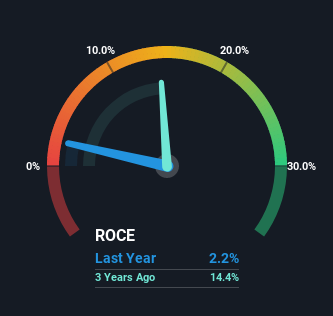- Hong Kong
- /
- Food and Staples Retail
- /
- SEHK:1705
The Returns On Capital At B & S International Holdings (HKG:1705) Don't Inspire Confidence

What are the early trends we should look for to identify a stock that could multiply in value over the long term? Firstly, we'd want to identify a growing return on capital employed (ROCE) and then alongside that, an ever-increasing base of capital employed. This shows us that it's a compounding machine, able to continually reinvest its earnings back into the business and generate higher returns. Having said that, from a first glance at B & S International Holdings (HKG:1705) we aren't jumping out of our chairs at how returns are trending, but let's have a deeper look.
Understanding Return On Capital Employed (ROCE)
If you haven't worked with ROCE before, it measures the 'return' (pre-tax profit) a company generates from capital employed in its business. To calculate this metric for B & S International Holdings, this is the formula:
Return on Capital Employed = Earnings Before Interest and Tax (EBIT) ÷ (Total Assets - Current Liabilities)
0.022 = HK$3.2m ÷ (HK$252m - HK$102m) (Based on the trailing twelve months to March 2022).
Therefore, B & S International Holdings has an ROCE of 2.2%. In absolute terms, that's a low return and it also under-performs the Consumer Retailing industry average of 11%.
Check out the opportunities and risks within the HK Consumer Retailing industry.

Historical performance is a great place to start when researching a stock so above you can see the gauge for B & S International Holdings' ROCE against it's prior returns. If you're interested in investigating B & S International Holdings' past further, check out this free graph of past earnings, revenue and cash flow.
What Does the ROCE Trend For B & S International Holdings Tell Us?
When we looked at the ROCE trend at B & S International Holdings, we didn't gain much confidence. Over the last five years, returns on capital have decreased to 2.2% from 56% five years ago. On the other hand, the company has been employing more capital without a corresponding improvement in sales in the last year, which could suggest these investments are longer term plays. It may take some time before the company starts to see any change in earnings from these investments.
On a side note, B & S International Holdings has done well to pay down its current liabilities to 41% of total assets. That could partly explain why the ROCE has dropped. What's more, this can reduce some aspects of risk to the business because now the company's suppliers or short-term creditors are funding less of its operations. Some would claim this reduces the business' efficiency at generating ROCE since it is now funding more of the operations with its own money. Either way, they're still at a pretty high level, so we'd like to see them fall further if possible.
The Bottom Line
Bringing it all together, while we're somewhat encouraged by B & S International Holdings' reinvestment in its own business, we're aware that returns are shrinking. And investors appear hesitant that the trends will pick up because the stock has fallen 54% in the last three years. On the whole, we aren't too inspired by the underlying trends and we think there may be better chances of finding a multi-bagger elsewhere.
If you want to know some of the risks facing B & S International Holdings we've found 3 warning signs (1 shouldn't be ignored!) that you should be aware of before investing here.
If you want to search for solid companies with great earnings, check out this free list of companies with good balance sheets and impressive returns on equity.
Valuation is complex, but we're here to simplify it.
Discover if B & S International Holdings might be undervalued or overvalued with our detailed analysis, featuring fair value estimates, potential risks, dividends, insider trades, and its financial condition.
Access Free AnalysisHave feedback on this article? Concerned about the content? Get in touch with us directly. Alternatively, email editorial-team (at) simplywallst.com.
This article by Simply Wall St is general in nature. We provide commentary based on historical data and analyst forecasts only using an unbiased methodology and our articles are not intended to be financial advice. It does not constitute a recommendation to buy or sell any stock, and does not take account of your objectives, or your financial situation. We aim to bring you long-term focused analysis driven by fundamental data. Note that our analysis may not factor in the latest price-sensitive company announcements or qualitative material. Simply Wall St has no position in any stocks mentioned.
About SEHK:1705
B & S International Holdings
An investment holding company, distributes and retails food and beverage products in Hong Kong.
Flawless balance sheet, good value and pays a dividend.
Market Insights
Community Narratives



